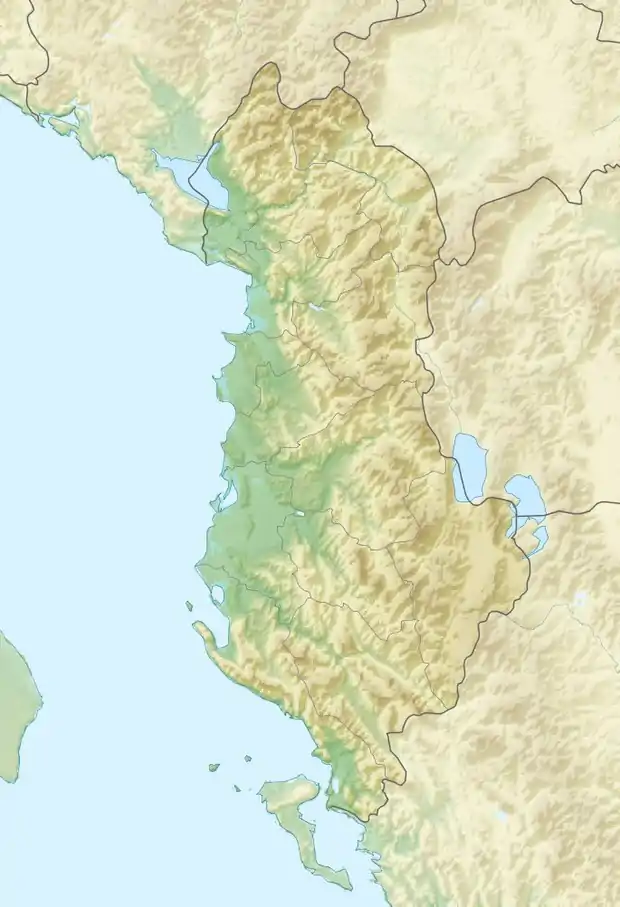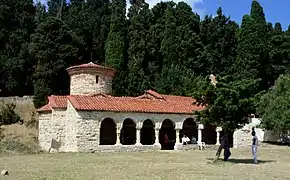Vjosa-Narta Protected Landscape
The Vjosa-Narta Protected Landscape (Albanian: Peisazh i Mbrojtur Vjosë-Nartë) is a protected landscape area in southwestern Albania.[2] It covers a total area of 194.12 square kilometres (74.95 sq mi), encompassing the lagoon of Narta along with the estuary of the Vjosë and its surrounding areas dotted with freshwater wetlands, marshlands, reed beds, woodlands, islands and sandy beaches. The International Union for Conservation of Nature (IUCN) has listed the park as Category VI. It is also listed as an important Bird and Plant Area, because it supports significant bird and plant species.[3][4]
| Vjosa-Narta Protected Landscape | |
|---|---|
IUCN category V (protected landscape/seascape) | |
.jpg.webp) | |
 Location within Albania  Vjosa-Narta Protected Landscape (Europe) | |
| Location | Vlorë County |
| Nearest city | Vlorë |
| Coordinates | 40°35′N 19°23′E |
| Area | 19,412 hectares (194.12 km2) |
| Established | 22 October 2004[1] |
Vjosa is considered to be Europe's last wild river and originates within the Pindus Mountains close to the border between Albania and Greece.[5] North of the Narta Lagoon is a watershed, whence the river drains into the Adriatic Sea. The shallow lagoon of Narta is separated from the Adriatic Sea by narrow sandy bar, which is covered with pine forests. At the same time it is also connected through two artificial channels with the sea. Located in the direct proximity to the Adriatic Sea, the landscape experiences mediterranean climate.[6] This means that the winters are mild and the summers are hot and dry.[6] The mediterranean character is marked by the annual distribution of precipitation, high in the winter months and moderate in the summer months.[6]
The landscape is part of a large preserved ecosystem collectively composed of various kinds of habitats, including pine and riverine forests, freshwater wetlands, salt marshlands, shrubs and sandy dunes. Despite occupying a relatively small area, 1400 vascular plant species have been observed in the landscape.[7] Forest makes up approximately 6 percent of the total land area. It is dominated by pine with species such as aleppo pine, maritime pine and stone pine, while the islands are mainly covered with mediterranean cypress, holm oak and downy oak.[7][8] Salt marshes are widely distributed around the coastline of the lagoon. Most notable plant communities amongst them are the salicornia, arthrocnemum and limonium.[7] The sandy dunes along the coast may reach up to 8 metres.
The wealth of fauna is reflected in the list of 741 species and subspecies recorded to date, composed by 32 species of mammals, 194 species of birds, 26 species of reptiles, 9 species of amphibia, 90 species of fish, 390 species of invertebrates and several other species.[9] Although, the landscape shelters 26 globally threatened species. Most important wildlife inhabiting the landscape include the flamingo, dalmatian pelican, golden jackal and dolphin.[9][10] Its rich number of birds is attributed to the three different types of water habitats it contains brackish, fresh and salt water. Most of the bird species have at least 6% of their total national population in the territory of the landscape.[11]
 |
 A wooden footbridge connects mainland to the island |
References
- Fletorja Zyrtare e Republikës së Shqipërisë. "FLETORJA ZYRTARE E REPUBLIKËS SË SHQIPËRISË" (PDF). qbz.gov.al (in Albanian). p. 3.
- "Management Plan Vjose-Narta Landscape Protected Area" (PDF). vinc.s.free.fr. p. 22.
- BirdLife International. "Narta Lagoon". datazone.birdlife.org.
- IUCN, World Wide Fund for Nature, Plantlife. "Important Plant Areas of the south and east Mediterranean region" (PDF). portals.iucn.org. p. 75.CS1 maint: multiple names: authors list (link)
- Fred Pearce. "Scientists demand halt to damming of Europe's last wild river". newscientist.com. Retrieved 23 September 2016.
- "Management Plan Vjose-Narta Landscape Protected Area" (PDF). vinc.s.free.fr. pp. 42–43.
- "Management Plan Vjose-Narta Landscape Protected Area" (PDF). vinc.s.free.fr. pp. 44–49.
- "Zonat e mbrojtura detare e bregdetare në Shqipëri" (PDF). al.undp.org (in Albanian and English). p. 22.
- "Management Plan Vjose-Narta Landscape Protected Area" (PDF). vinc.s.free.fr. pp. 49–52.
- "Protected area gap assessment, marine biodiversity and legislation on marine protected areas" (PDF). undp.org. p. 10.
- "Management Plan Vjose-Narta Landscape Protected Area" (PDF). vinc.s.free.fr. pp. 76–78.
External links
![]() Media related to Narta Lagoon at Wikimedia Commons
Media related to Narta Lagoon at Wikimedia Commons
